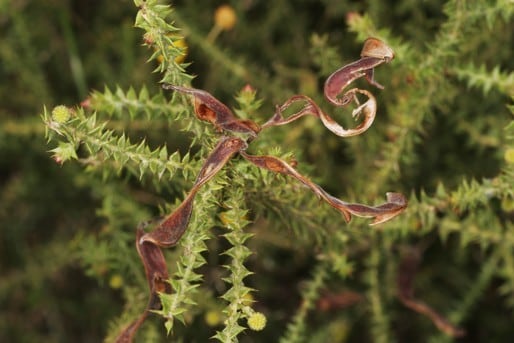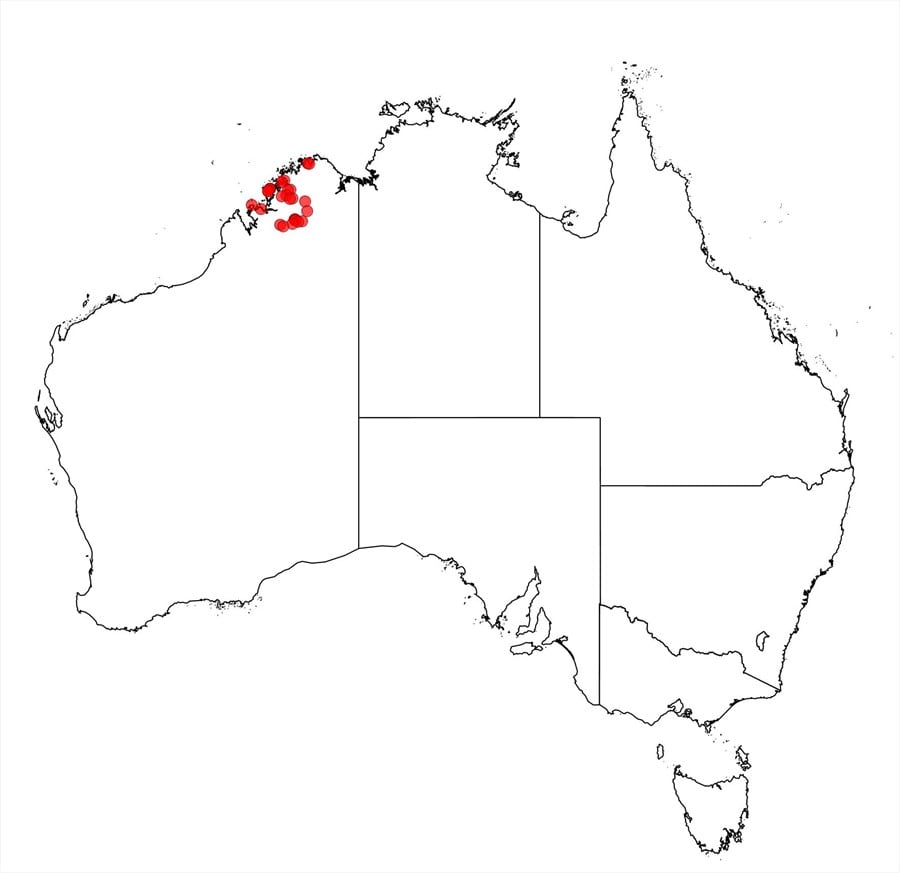Acacia adenogonia (Pedley) R.S.Cowan & Maslin
WATTLE
Acacias of Australia
Family
Fabaceae
Distribution
Occurs in scattered populations in the West Kimberley in the Bonaparte Archipelago, the Napier and Broome Bay areas and inland at Kimberley Downs Stn, Beverley Springs Stn and Phillips Ra, W.A.
Description
Erect to sprawling shrub 1–2 m high. Branchlets terete, usually canescent-villous, sometimes with scattered shorter glandular hairs. Stipules persistent, subulate, partly united, to 6.5 mm long. Phyllodes sessile to subsessile, patent to inclined, inequilaterally ovate to lanceolate, straight, (3–) 5–10 (–15) mm long, 1.5–4.5 mm wide, acuminate-pungent, coriaceous, usually subglabrous to villous, with 3 or 4 distant nerves and with few anastomoses; gland often projecting beyond phyllode-margin, 2–5 mm above base. Inflorescences simple, 1 per axil; peduncles (3–) 7.5–14 mm long, usually villous; heads globular, 4–6 mm diam., 60–92-flowered, golden; bracteoles linear to narrowly lanceolate, exserted in buds. Flowers 5-merous; sepals 1/2-united. Pods linear, raised over and irregularly ±constricted between seeds, curved, to 8.5 cm long, (4–) 5–6.5 mm wide, thinly coriaceous, canescent-puberulous with intermixed longer gland-tipped hairs. Seeds longitudinal, elliptic-oblong, 6–6.5 mm long, dull, brown-black; aril terminal.
Habitat
Grows in sandy soil usually on sandstone in woodland.
Specimens
W.A.: Gibb R. Rd, 1.5 km W of Lennard R. Gorge turn-off, G.W.Carr 4115 & A.C.Beauglehole 47893 (BRI, CANB, K, MEL, PERTH); Pim Hill, E.A.Chesterfield 385 (PERTH); Naturalist Is. in Prince Frederick Harbour, W of entrance to Hunter R., K.F.Kenneally 9926 (PERTH).
Notes
A member of the ‘A. deltoidea’ group. Closely related to A. deltoidea which has differently shaped, thicker phyllodes, different branchlet pubescence, non-exserted phyllode glands and broader pods with oblique-transversely oriented seeds; its seed orientation is more like that of A. sublanata which has phyllodes broadest at or above the middle and a cupular calyx. Also related to A. froggattii.
Bentham referred to the type collection of A. adenogonia as questionably a variety of A. deltoidea, saying it might represent a distinct species.
The available material appears to indicate two forms comprising the species, one along the north coast of W.A. and the nearby offshore islands (see fig. 1Q–S in R.S.Cowan & B.R.Maslin, Nuytsia 7: 203 (1990)), the other along the Gibb R. Rd in the area of Beverley Springs HS about 250 km S (see fig. 1 O–P in R.S.Cowan & B.R.Maslin, Nuytsia 7: 203 (1990)). The latter population has somewhat larger phyllodes which are villous, rather than obscurely puberulous as in the coastal form. A flowering glabrous variant is found W of Rankin Is., Collier Bay (K.F.Kenneally 10521, PERTH).
FOA Reference
Data derived from Flora of Australia Volumes 11A (2001), 11B (2001) and 12 (1998), products of ABRS, ©Commonwealth of Australia
Author
R.S.Cowan
Minor edits by J.Reid & J.Rogers
This identification key and fact sheets are available as a mobile application:
URL: https://apps.lucidcentral.org/wattle/
© Copyright 2018. All rights reserved.










